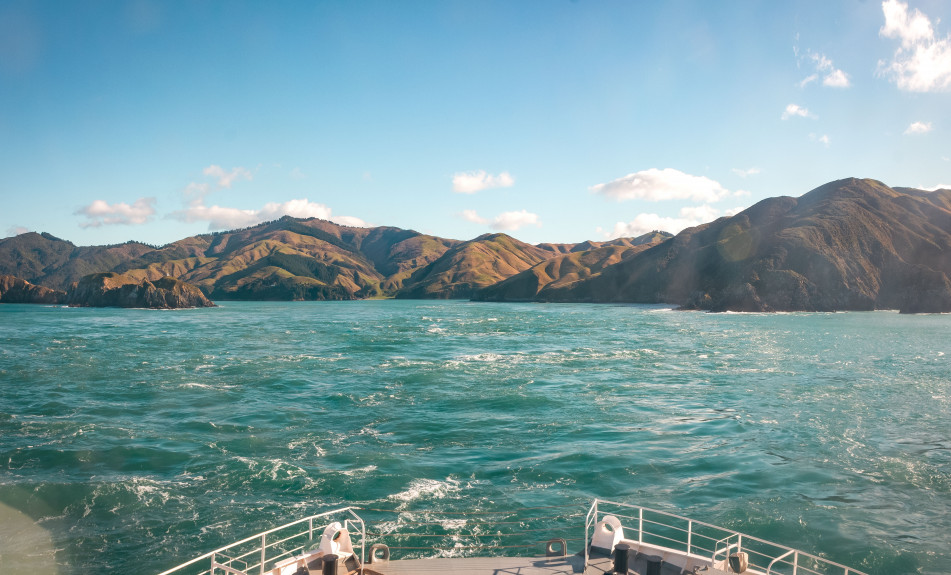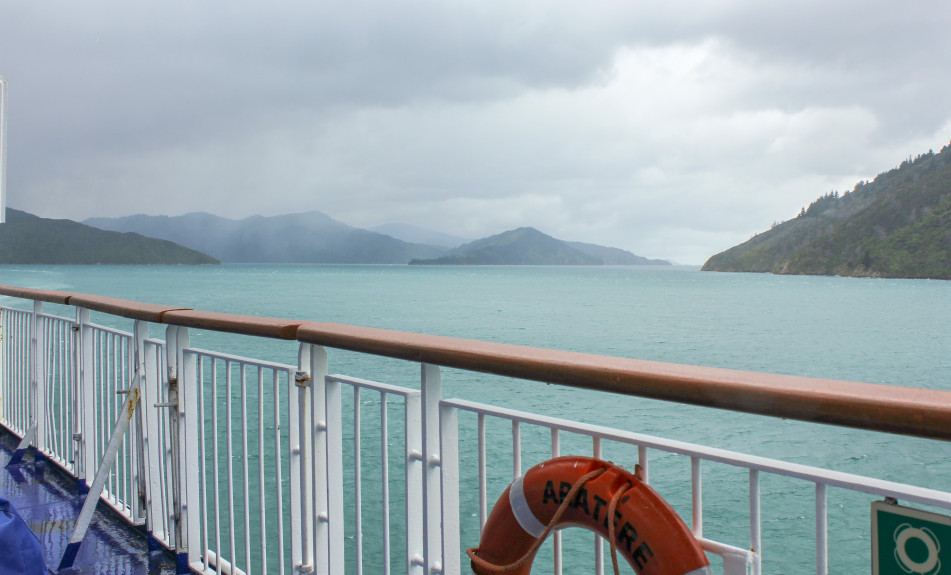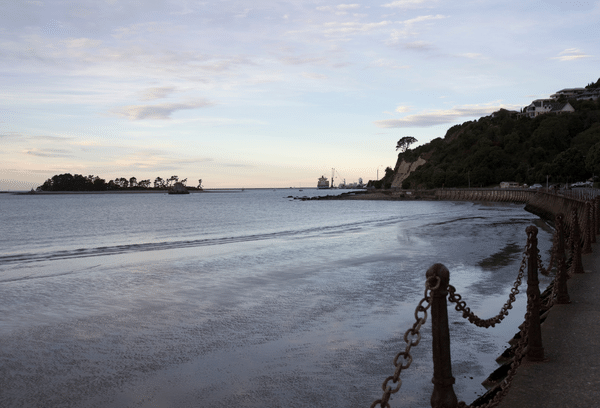Smile through the seasickness
The sun has turned it on big time today. You can feel it warm your face as you overlook the sea, the waves rising and falling around the boat. Rising and falling, over and over. You bob along with the motion of the boat until it hits you like a ship...

Taking in the scenery on Kaiarahi
Sorry to take you there. But if feeling seasick is something you have to put up with every time you get on board a boat, whether it's a little tin dinghy a reliable ferry or a gigantic cruise ship, then we have a few tips for getting through it.
How to avoid seasickness on the Cook Strait ferry
The Interislander is considered one of the world’s most beautiful ferry journeys in the world so we want you to treasure your journey with us. But that can be difficult with a veil of green sweeping over your face. So if you’re susceptible to motion sickness, it’s as simple as being prepared for the worst.
Watch what you indulge in
If you know you’ve got a ferry to catch within 24 hours, it’s always best to think about what food and drink you’re putting in your body. Avoid anything too bubbly, that includes booze and you’re favourite fizzy drinks. And perhaps try holding back from any spicy or greasy food. Leave those Thai takeaway leftovers from last night behind. It’ll only upset you later.
Don't sail on an empty stomach
You can actually make yourself more susceptible to motion sickness if you travel with nothing in the tank. An hour before you go, have a little snack of crackers, pretzels or something mild to settle your stomach. And continue nibbling on light, bland snacks that are low in fat and acid throughout the voyage.
Avoid strong odours
If you can help it, steer clear of any foul smells. When you see someone digging into their Tupperware filled with some rather questionable lunch, turn your nose the other way. That nasty egg salad isn’t good for anyone’s nostrils. And always remember, never sit downwind from the bathrooms —for obvious reasons.
Try sea bands
These handy bands are made of knitted elastic, with a small plastic stud applying pressure to the Nei Kuan acupressure point on each wrist. A drug-free preventative step you can take that is safe for adults, children and pregnant women too. You can find sea bands at most pharmacies — they even come in funky colours and patterns.
Snack on some ginger
Used for thousands of years in Chinese Medicine, this pungent and spicy root has long been known as a great preventative for motion sickness. Many passengers swear by it, insisting that eating ginger in some form before and during the voyage can help lessen or ward off oncoming seasickness. Whether you chew ginger fresh, dried, crystalised or in candy form, this natural hack is a good one to keep in mind.
Medication
If you’ve tried all the seasick remedies you can think of and none of them seem to work, try some over-the-counter drugs, such as Scopolamine Patches. Applied on the skin behind your ear four hours before you set sail, these patches gradually release scopolamine (great for nausea) for your body to absorb. There can be side effects, so do some research and talk to a health professional before you buy them.
Get a sickbag
Unfortunately, sometimes there’s simply nothing you can do once the feeling hits. Sick bags are available on board Interislander. So it's always best to be prepared and grab one (or two) before you settle into your seat.

Approaching the Tory Channel
Sailing when the weathers wild
On the Interislander, we only set sail in safe conditions. But if there's a storm-a-brewing’ on the day you’re booked to set off (and you think it could cause some bothersome belly activity) then you’re welcome to consider embarking on your journey at a later stage.
Check the conditions
If you’re really concerned, check the swell online before you go. Or if you’re travelling on the Interislander ferry, chat to one of the friendly crew before boarding. Rest assured if conditions are too rough or it's unsafe, sailing will be cancelled or delayed for another time. You can check our website for up-to-date Interislander arrival times, departures and to find out more about receiving notifications about ferry delays.
Cancellations
Changing your sailing is easy. If you want to delay your trip and go on a sunny day, you can change the date of your expedition free of charge for up to one hour before you’re set to sail off. See the fare conditions on your booking confirmation if you want to cancel your sailing entirely. For more information about cancellations and different fare types on offer, see our website.

The view of a moody day from Aratere
During the crossing
While the journey on the Cook Strait ferry is a beautiful one, rain or sun, it can get pretty choppy. We weren’t all born with sea legs, so here are a few suggestions on how to prevent seasickness to get you through.
Face forward
If you can help it, try sitting in a forward-facing seat and avoid reading or looking down. Focus on the horizon or any fixed object in the distance like a mountain or building. If you start to feel nauseous while scrolling on your phone, put it down and either close your eyes or look at the horizon.
Choose your seat wisely
Where you sit on board a boat can really affect how you feel. Typically towards the rear of the ferry is the most stable with the least motion. And if possible, sit as close to water level as you can, the higher above the water you are the more movement you’ll feel. And as mentioned earlier, try finding a seat facing the direction you’re travelling in, with a view of the horizon and easy access to fresh air as well.
Have a nap
If you’re the kind of person who falls asleep at the drop of a hat, then try to nap it out until the journey is over. Yes, you’ll miss some of the beautiful sights along the way, but chances are you’ll also miss the otherwise inevitable seasickness you’re prone to.
Get out of your seat
A bit of crisp wind can alleviate the symptoms of seasickness. So get up and move around a bit. Get some fresh air, but keep looking at that horizon and not the rolling waves. Above all else, if you notice someone else hit by a wave of seasickness, move away from them. It can be a bit contagious. And if you see anyone reaching for their sick bag, get out of there.
Talk to the crew
Give the team onboard a heads up if you aren’t feeling too flash. They will likely remind you of some of the hints we’ve mentioned, and give you a piece of ice to pop in your mouth. One of the simplest home remedies, sucking an ice cube can help calm the stomach and prevent queasiness.
It's smooth sailing from here
Motion sickness is caused by your senses getting into a tizzy. Your eyes and ears get mixed messages about the movement going on around you. It’s nothing to be embarrassed about. You aren’t the first person to experience seasickness and you certainly won’t be the last. So whether you’re sensitive to seasickness or you’re a bit worried about cruising in rough conditions, take these pointers and do your best to enjoy the journey. We look forward to welcoming you aboard and getting you across Cook Strait as smoothly as possible.



